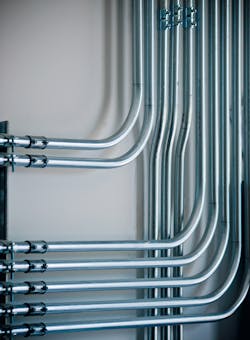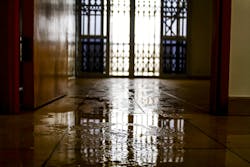Everyone knows water and electricity are a dangerous combination. Just ask any electrician or inspector who’s dealt with the aftermath of a natural disaster. While many articles explain how to deal with the aftermath of electrical equipment exposed to water, little information is available on what to do with electrical conduit. Here are six steps for restoring an electrical system using galvanized steel conduit, along with important reminders about the conduit construction and corrosion protection. It’s important to note these raceways may be available in steel, stainless steel, red brass, or aluminum. For this article, we will address only galvanized steel products.
Steel Conduit Construction Guidelines
Before getting into the restoration steps, let’s review the guidelines for raceway construction. There are three types of steel conduit: rigid metal conduit (RMC), intermediate metal conduit (IMC), and electrical metallic tubing (EMT). Each type has unique properties and construction, and each is manufactured to a different UL standard (see Table).
Among many other criteria, these standards require the manufacturer to apply corrosion protection, which is most often in the form of zinc galvanization, on the product’s exterior, and either zinc galvanization or an organic coating (paint) on the interior.
The National Electrical Code (NEC) requires each of these raceways to be listed (Table). Section 300.6(A) of the Code addresses corrosion protection for ferrous metal equipment, including raceways, by mandating a coating of approved corrosion-resistant material, both inside and out. The NEC defines “approved” as being acceptable to the Authority Having Jurisdiction (AHJ) — this concept will be discussed more later. Since each of the raceways being examined must be listed — and the listing requires corrosion protection — they meet the requirements of Sec. 300.6 as delivered from the manufacturer.
Corrosion Protection
Zinc galvanizing has been used for more than 200 years to combat corrosion of iron and steel. The zinc protects the underlying steel in two ways: by providing a barrier coat between the steel and the environment and by providing sacrificial galvanic protection. As a barrier coat, zinc leaves fine white powder deposits on the steel, often referred to as “white rust.” Actual steel rust is a red powder, so the presence of white rust illustrates that the galvanizing is doing its job. In the presence of an electrolyte, either an acid or a base, a mild battery effect will take place where metals of different “nobilities” are present. Being a less chemically noble metal than steel, zinc sacrifices itself by protecting the steel underneath from electrolytes.
Steel conduit listing standards contain several requirements and tests that must be passed before the product can be approved and identified with a listing mark from a Nationally Recognized Testing Laboratory (NRTL). NRTLs require the galvanization to adhere tightly without blistering, peeling, or cracking even under bending stresses, and the raceway coating must pass a copper sulfate (Preece) test to ensure the quality and thickness of the galvanization.
As a final line of defense for EMT (UL 797) and IMC (UL 1242), the application of a thin clear organic conversion coating over the zinc galvanizing is allowed. This is a chemical process in which the surface is converted into a thin, clear coating that protects the zinc from contact with the environment, further enhancing the product’s ability to combat corrosion. While not required, every conduit-manufacturing member of the Steel Tube Institute provides this extra measure of protection.
It’s helpful to keep in mind how steel conduit is made when evaluating and restoring an electrical system that’s been through a flood or a natural disaster. The following six steps will help you through the process.
1. Evaluate the Situation.
When evaluating the status of recently flooded steel conduit, first consider the cause of the flooding and the associated contaminants that might have been in the water. Did the water come from a broken domestic water pipe or rainwater, a marine environment, or a flood situation over a wide area?
Domestic water and rainwater might contain trace impurities, but are not considered to be excessively corrosive, especially if mitigated quickly; therefore, there might be little concern regarding damage to the conduit. Remember that the zinc galvanization applied at the factory allows conduit to be installed in wet locations (with proper fittings) and buried in the earth, so some exposure to uncontaminated water is acceptable. On the other hand, sea water has a high salt content and can quickly attack and corrode iron and steel. True floodwater, as experienced in major storms or levee breaches, typically inundates large areas and compromises most aspects of sanitary infrastructure. As such, this “water” might contain industrial products, solvents, acids, and other biological hazards that can damage the conduit. Regardless of the cause of flooding, you should always check the conductors for damage as outlined below.
2. Remove and Examine the Conductors.
Conduit is designed to allow for the removal of conductors when necessary, so you should always remove them for examination after a flood situation. This is a significant advantage to installing steel conduit from the outset. If the installation is in a normally dry location — and the conductors or cables are listed only for dry locations — NEMA’s “Evaluating Water-Damaged Electrical Equipment” guide recommends replacing the conductors. If the conductors are rated for wet locations, withdraw the conductors from the raceway, and visually inspect them for damage. An insulation test may be performed to verify the integrity of the insulation on the cable or conductor. The conduit itself may be reconditioned after being subjected to water damage, per the NEMA guide.
3. Flush and Dry the Raceway.
Unless the floodwater was uncontaminated, you should flush the interior of the raceway with fresh water. This step neutralizes any corrosives left inside and loosens any silt or debris. Then pull an absorbent cloth through the raceway to dry the interior. Forced air can be used to hasten the complete drying of the conduit.
4.Inspect all components of the raceway.
Exterior — Inspect the outside of the steel conduit for signs of damage, especially to the coatings. Exposure to caustic or acidic fluids could compromise the protective galvanized coating. Remember, if red rust is visible, the zinc coating has been penetrated, and the steel is corroding. If white rust is visible, the zinc galvanization is still present and performing as intended.
Interior — Keep in mind that exposure to caustic or acidic fluids could also compromise the interior coating and potentially reduce the conduit’s interior cross-sectional area. A small reduction might not be problematic, especially if the raceway will not be filled to near capacity with conductors. To verify if the diameter is still adequate, simply pull a mandrel of the correct size through the raceway. This step will also verify the absence of foreign particles that could damage the conductor insulation.
Fittings — Don’t forget to inspect the couplings, connectors, and other fittings to ensure the integrity and continuity of the raceway connections. They are critical to maintaining the system’s electrical safety by providing the low-impedance ground fault current path required in NEC Sec. 250.4(A)(5) and (B)(4). It is important to understand that the steel raceway is the primary fault current path, whether it is the only equipment grounding conductor (EGC) or a wire-type EGC is also installed within the raceway.
Threads — Inspect threaded raceway systems to ensure the threaded conduit and couplings, fittings, and locknuts are tight and free of corrosion and contamination. If the conduit has not been compromised, most likely the factory-cut threads still provide the required grounding safety because the manufacturer protected the threads in the method required by the applicable standard. Field-cut threads should be visually inspected to verify integrity of the thread protection that was applied in the field, as mandated by NEC Sec. 300.6(A). For EMT, or for non-threaded RMC or IMC, the fittings must be inspected like threaded connections for corrosion, contamination, or otherwise impaired contact.
5. Decide Whether to Put the Raceway Back into Service.
Now that the steel conduit has been flushed, dried, and inspected for damage, it’s time to make a decision. If there is little evidence of damage or deterioration, the raceway can be put back into service. Small areas can be repaired with zinc-rich paint, acrylic, urethane, weather-stable epoxy, bitumastic coating, or a zinc-based solder. If paint is used, the zinc dust concentration should be 65% to 69%, or above 92% in dry film.
If the damage to the galvanization is severe — or if the raceway is not accessible enough to allow for thorough inspection — the long-term viability of the raceway system must be evaluated. A raceway inside a building in a normally dry or conditioned area might be suitable for continued service, but first the AHJ — often the local municipal inspection agency — must be consulted.
From a practical standpoint, it is not feasible to recondition a metal raceway if there is extensive corrosion or if there is significant mechanical damage. In either case, the raceway or the damaged section would need to be replaced.
6. Reinstall the Conductors, and Test the System.
After reinstallation of conductors, check with the local municipality regarding the regulations and policy for your specific situation. In many cases, reusing equipment is not regulated if it was inspected at the time of initial installation. In the case of a major, area-wide event — and if electrical service was disconnected — an inspection might be required before re-energizing the structure. The inspection entity may be the local municipal inspection agency. However, if the local inspection agency is not involved, the AHJ can be the building owner, an engineer or design professional, an insurance company, or another entity. After the AHJ has approved the installation, the system can be energized and tested for proper function.
7. Use Your Best Judgment
Obviously, there are no absolutes when determining if a metal raceway system may be reused. Numerous conditions must be considered, including the extent of any damage, the system’s environment and the anticipated life of the installation, among others. An informed, expert evaluation of the system will ensure its safety and provide satisfactory long-term performance. If there is any doubt about the integrity of the metal conduit system, contact the manufacturer of the conduit for assistance and advice. Additional information on steel conduit may be found at www.steeltubeinstitute.org.
Andre is a licensed master electrician in Washington State. He is an electrical inspector for the state and the inspection supervisor/assistant building official for the city of Bellevue, Wash. He also currently serves as a consultant for the Steel Tube Institute and an instructor for the National Fire Protection Association (NFPA) on the National Electrical Code. He can be reached at [email protected].



